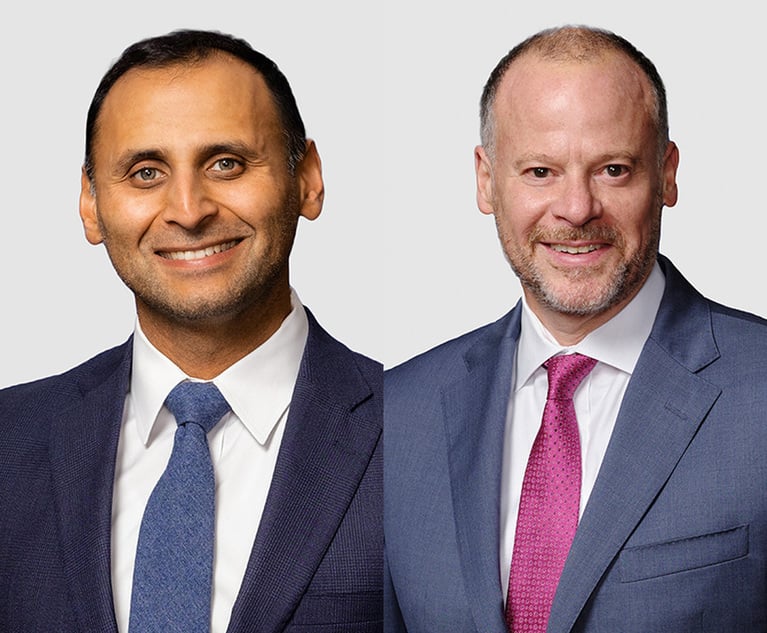 Julie Talenfeld of BoardRoom PR.
Julie Talenfeld of BoardRoom PR.Six Questions on the Power—and Limits—of Litigation Communications
Your firm is representing a client involved in a high-profile lawsuit. You know the matter is locally, regionally, even nationally newsworthy. Whether the plaintiff or respondent or defendant, your client has a story to tell or a message to share.
May 31, 2019 at 12:56 PM
5 minute read
The original version of this story was published on Daily Business Review
Your firm is representing a client involved in a high-profile lawsuit. You know the matter is locally, regionally, even nationally newsworthy. Whether the plaintiff or respondent or defendant, your client has a story to tell or a message to share.
Whether you're first out of the gate with a media message, or responding to opposing counsel's public statements, your message or response can be critical to ensuring your side is heard. This can be especially true for matters being tried in court, and the court of public opinion.
Sharing them appropriately, tastefully and within the bounds of the state bar association regulations can ensure your message is embraced by recipients and not thwarted by regulatory powers.
Litigation communications can be critical to any law firm's marketing program. Along with advertising, blogging and marketing communications, media relations can be central to getting the firm's message out to journalists and their readers.
What is the appropriate and allowable venue for your firm to share your client's message or response to opposing counsel's comments?
Some abhor the concept of “trying their case in the media.” To be sure, there are appropriate and inappropriate, even improper, times to take your story public. Sometimes, however, it's unavoidable or “just happens” if the media learns of your matter and inquires, thus forcing a response.
How can your firm effectively and appropriately execute on litigation communications? Media relations often is the solution. This highly specialized and sensitive niche within the greater scope of marketing communications can be effective in driving firm, client, or litigation-specific messaging.
Consider these six questions when establishing a communications plan designed for specific litigation:
- Should you seek any media at all?
This question opens up a decision tree. If you and your client determine no media coverage should be sought, reporter questions should receive a “No comment,” or if the judge has issued a gag order, then your decision is simple. If you decide to pursue or respond to the media, continue on. As a caveat, once a case has been brought to conclusion and any embargos or gag orders have been lifted, the following questions should be considered.
- Who will be the case's voice?
If your case is likely to find media interest, decide early on who should be the spokesperson. The lead attorney can be the voice of the case, even if the client is occasionally made available as the “face” that personalizes the case. But making this decision early can clarify your approach.
- Should you proactively seek media exposure?
Whether at the start or completion of a case, high-profile matters command attention. Imagine a class-action lawsuit in an issue that's been widely covered, or a celebrity or well-known individual is involved in a public entanglement, or a unique, “man bites dog” story in which the public and media are interested. Similarly with multimillion dollar settlements or verdicts, precedent-setting rulings, or other noteworthy outcomes, they may command attention. Anticipate that as counsel in the case, a reporter's call will come. Prepare a press release or speaking points to help tell your client's story.
- What if the media calls unsolicited? Do we take the call?
When a reporter calls in response to a press release, your media relations effort has been a success. But what if a reporter calls about your case unsolicited? Make sure the spokesperson is the only person to whom the receptionist steers the call. Relevant talking points should be decided in advance; adhere to how much—or little—you decide to discuss.
- How can you control the story?
“Getting in front of the coverage” is an important strategy for certain public matters. From issuing statements and press releases, to staging news conferences to gather the media in one location to present your client's case, the first to speak often sets the dialogue. It may be smart to beat opposing counsel to the microphone.
- Should you hire a litigation communications firm?
After asking yourself these questions, would you be best served to hire a media relations team that specializes in legal services? You can focus on the case; the media relations firm can focus on message delivery.
Finally, keep in mind the court and Florida Bar rules may affect your litigation communications strategy. If the trial judge warned against or placed a gag order on trial or proceedings, this will guide your outreach or response.
Additionally, legal services advertising, marketing and communication must comply to rules under Florida Bar Subchapter 4-7. More directly, Florida Bar Rule 4-7.11 states that lawyers are not required to file for review any press release “if the press release is provided solely to legitimate media outlets where the media outlets have complete editorial control, including whether to print any information in the press release, and where the media outlet is not paid to print information from the press release.”
Effective litigation communications can ensure you and your client control the message told to the media, the marketplace and possibly the court of public opinion.
Julie Talenfeld is the president of BoardroomPR, one of Florida's premier litigation communications agencies. She can be reached at [email protected]
This content has been archived. It is available through our partners, LexisNexis® and Bloomberg Law.
To view this content, please continue to their sites.
Not a Lexis Subscriber?
Subscribe Now
Not a Bloomberg Law Subscriber?
Subscribe Now
NOT FOR REPRINT
© 2024 ALM Global, LLC, All Rights Reserved. Request academic re-use from www.copyright.com. All other uses, submit a request to [email protected]. For more information visit Asset & Logo Licensing.
You Might Like
View All
Trying a Case for Abu Ghraib Detainees Two Decades After Abuse

Should It Be Left to the Plaintiffs Bar to Enforce Judicial Privacy Laws?
7 minute readTrending Stories
- 1Daniel Habib to Serve as Next Attorney-in-Charge of NY Federal Defender Appeals Unit
- 2Protecting Attorney-Client Privilege in the Modern Age of Communications
- 3High-Profile Sidley M&A Partner Heads to Covington
- 4Stars and Gripes: Firms Need a 'Superstar Culture' to Crack the U.S. Market
- 5BCLP Exploring Merger Prospects as Profitability Lags, Partnership Shrinks
Who Got The Work
Michael G. Bongiorno, Andrew Scott Dulberg and Elizabeth E. Driscoll from Wilmer Cutler Pickering Hale and Dorr have stepped in to represent Symbotic Inc., an A.I.-enabled technology platform that focuses on increasing supply chain efficiency, and other defendants in a pending shareholder derivative lawsuit. The case, filed Oct. 2 in Massachusetts District Court by the Brown Law Firm on behalf of Stephen Austen, accuses certain officers and directors of misleading investors in regard to Symbotic's potential for margin growth by failing to disclose that the company was not equipped to timely deploy its systems or manage expenses through project delays. The case, assigned to U.S. District Judge Nathaniel M. Gorton, is 1:24-cv-12522, Austen v. Cohen et al.
Who Got The Work
Edmund Polubinski and Marie Killmond of Davis Polk & Wardwell have entered appearances for data platform software development company MongoDB and other defendants in a pending shareholder derivative lawsuit. The action, filed Oct. 7 in New York Southern District Court by the Brown Law Firm, accuses the company's directors and/or officers of falsely expressing confidence in the company’s restructuring of its sales incentive plan and downplaying the severity of decreases in its upfront commitments. The case is 1:24-cv-07594, Roy v. Ittycheria et al.
Who Got The Work
Amy O. Bruchs and Kurt F. Ellison of Michael Best & Friedrich have entered appearances for Epic Systems Corp. in a pending employment discrimination lawsuit. The suit was filed Sept. 7 in Wisconsin Western District Court by Levine Eisberner LLC and Siri & Glimstad on behalf of a project manager who claims that he was wrongfully terminated after applying for a religious exemption to the defendant's COVID-19 vaccine mandate. The case, assigned to U.S. Magistrate Judge Anita Marie Boor, is 3:24-cv-00630, Secker, Nathan v. Epic Systems Corporation.
Who Got The Work
David X. Sullivan, Thomas J. Finn and Gregory A. Hall from McCarter & English have entered appearances for Sunrun Installation Services in a pending civil rights lawsuit. The complaint was filed Sept. 4 in Connecticut District Court by attorney Robert M. Berke on behalf of former employee George Edward Steins, who was arrested and charged with employing an unregistered home improvement salesperson. The complaint alleges that had Sunrun informed the Connecticut Department of Consumer Protection that the plaintiff's employment had ended in 2017 and that he no longer held Sunrun's home improvement contractor license, he would not have been hit with charges, which were dismissed in May 2024. The case, assigned to U.S. District Judge Jeffrey A. Meyer, is 3:24-cv-01423, Steins v. Sunrun, Inc. et al.
Who Got The Work
Greenberg Traurig shareholder Joshua L. Raskin has entered an appearance for boohoo.com UK Ltd. in a pending patent infringement lawsuit. The suit, filed Sept. 3 in Texas Eastern District Court by Rozier Hardt McDonough on behalf of Alto Dynamics, asserts five patents related to an online shopping platform. The case, assigned to U.S. District Judge Rodney Gilstrap, is 2:24-cv-00719, Alto Dynamics, LLC v. boohoo.com UK Limited.
Featured Firms
Law Offices of Gary Martin Hays & Associates, P.C.
(470) 294-1674
Law Offices of Mark E. Salomone
(857) 444-6468
Smith & Hassler
(713) 739-1250








